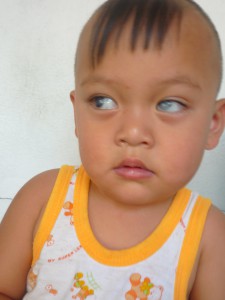Eye Conditions/Disorders

Wai Linn Phyo is ready for surgery to treat Congenital Glaucoma
- Congenital Glaucoma is caused by increased pressure inside the eye. In a healthy eye, the fluid leaves through a network of cells and tissue that functions as a tiny drain. To replace the fluid that drains, the eye continuously makes just the right amount of more fluid. In patients with glaucoma, something happens to upset that balance and the fluid doesn’t drain properly. The buildup of fluid causes the eye pressure to rise. If left untreated, vision loss can occur and may eventually result in blindness. Surgery is typically required to treat glaucoma.
- Childhood Cataracts are a cloudy or opaque area in the lens located directly behind the iris inside the eye. Normally, the lens is clear and allows light entering the eye to clearly focus an image on the retina. When cataracts develop, the light rays become scattered as they pass through the cloudy lens and the retinal image becomes blurred and distorted. Cataracts may be present at birth (congenital) or may develop following trauma or injury to the eye. Surgical removal of a cataract is done under general anesthesia using an operating microscope.
- Retinoblastoma is a cancerous tumor that grows in the retina, a layer of nerve tissue in the back of the eye that senses light and sends images to the brain. A cancer of early childhood, retinoblastoma can affect children up to 5 years of age. The risk of death from retinoblastoma is greater in developing countries where diagnosis may be delayed and treatment may be inadequate or unavailable. In developing countries, if retinoblastoma is not diagnosed until a later stage of the disease, tumors may have often already spread outside the eye. Fatality rates in developing countries may be 60 percent or higher, whereas in developed countries the death rate has been reported to be as low as 1 or 2 percent. For BCMF, this means it is essential to diagnose and treat patients as early as possible.


